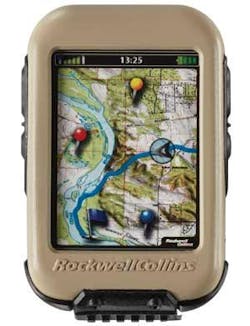ByJohn McHale
WASHINGTON–Engineers at Rockwell Collins in Cedar Rapids, Iowa, introduced a GPS receiver called the MicroDAGR for infantry soldiers that is small enough to be worn on wrist.
The MicroDAGR is the latest generation of Rockwell Collins’ Defense Advanced GPS Receiver (DAGR) device, used by the military for position and navigation, says Preston Johnson, manager, business development, soldier systems for Rockwell Collins. “We found that they wanted many of the features found in current commercial handheld devices, such as an MP3 player and a digital camera,” Johnson says.
Warfighters will use the MicroDAGR to “record geo-rectified images of the battlefield for after-action review and analysis, listen to foreign language translations of important commands and phrases, and get silent alerts from their MicroDAGR when they reach preprogrammed waypoints and/or danger areas,” Rockwell Collins officials say.
Johnson made his comments during a briefing at the Association of the U.S. Army Annual Meeting & Exposition in Washington last month. Rockwell Collins announced the MicroDAGR at the event.
Other device features include real-time position, navigation, moving maps, and timing information on a full-color, touch-screen display, and is small enough to be worn on the wrist, attached to a lanyard, or placed in a pocket, according to a Rockwell Collins announcement.
The typical black-and-white display on the original DAGR did not clearly show blue/red force tracking as seen on an FBCB2 computer, Johnson explains. It also is necessary for the digital camera function, which can be used to take pictures of improvised explosive devices (IEDs) and other key targets, Johnson notes.
Johnson says the system uses a general-purpose processor, and a proprietary real-time operating system, but declined to name suppliers.
The MicroDAGR also has anti-jamming and anti-spoofing capability, as it has the latest Selective Availability Anti-Spoofing Module (SAASM)-based anti-jamming software, Johnson says. Johnson, a former Special Operations officer, says that when he served, soldiers would use an off-the-shelf Garmin GPS, which worked fine but could easily be jammed.
Even more dangerous than jamming it could be spoofed into providing incorrect coordinates, which “gets guys killed in a hurry,” Johnson continues.
Warfighters themselves also can add functionality to the MicroDAGR much the same way individuals create applications for their iPhones, Johnson says. Soldiers are creating their own “apps” based on mission requirements or personal preference, he adds.
Working with handheld computers comes naturally to today’s troops, as most of them under 30 grew up with this type of technology, Johnson notes. Future enhancements include mission planning, multiple languages, and L2 frequency, which improves position accuracy and jamming performance, according to the MicroDAGR data sheet.
The MicroDAGR will not have wireless networking capability yet because the National Security Agency still does think it is secure enough, Johnson says. Rockwell Collins will provide the first MicroDAGRs to the U.S. Army Rapid Equipping Force (REF) at the beginning of next year, Johnson says.
More Military & Aerospace Electronics Current Issue Articles
More Military & Aerospace Electronics Archives Issue Articles




